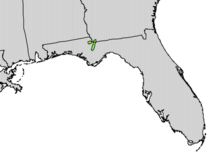Torreya Guardians
Founded in the early 2000s, the group is often mentioned as an instigator of the assisted migration of forests in North America for conservation and climate adaptation purposes.
"[8] She concluded, "To track climatic changes in the future, caused by the greenhouse effect, however, their range limit would need to move northward 100 km per °C warming....
[21] Instead, the United States Fish and Wildlife Service was trying to protect this species by managing the diseases affecting it in its native range at the time, with limited success.
[12] Since the species listing in 1984, the official conservation efforts undertaken in behalf of the Florida torreya centered first on collecting and rooting cut branchlets from specimens in the wild.
[22] As those cuttings turned into shrubs, they were transferred into large pots or moved into managed horticultural plantings for genetic safeguarding until problems in the habitat itself could be discerned and corrected.
Connie Barlow, on the other hand, believed that it made little sense to focus on finding a way to return torreya to its endemic habitat during a time of climate warming.
"[23] The two sides had come to a head in 2004 when the environmentalist magazine Wild Earth published a pair of detailed pro and con articles on what to do about the Florida torreya.
[24] Connie Barlow and paleoecologist Paul S. Martin wrote the essay in favor of moving the species,[25] citing evidence that the Florida torreya had been pushed south during the previous ice age.
[5][26] Mark W. Schwartz, an American conservation biologist who had been researching and participating in the preservation of the Florida torreya within its native range since 1988, wrote the piece opposing the assisted migration proposal.
Provided there is no monetary transaction, private citizens can legally carry or send horticulturally sourced specimens of listed endangered species.
[30] The nascent Torreya Guardians took advantage of this legal exception to the Endangered Species Act to implement their own assisted migration project outside established institutions.
Such in-forest plantings represent the group's emphasis not just in preventing extinction but also in re-integrating—that is, "rewilding"—this subcanopy species into native forest ecologies of the eastern United States.
[39] Several volunteer planters are trained (and sometimes employed) as professional ecologists or foresters, but most have acquired horticultural skills outside of a profession and are eager to assist an endangered plant.
[46] A press report on the regulatory change mentioned the citizen actions of Torreya Guardians as having preceded the official shift in willingness to consider northward experiments for other endangered species.
[46] Following the regulatory change, another journalist wrote that the "aggressive approach to conservation" by the Torreya Guardians "featured prominently in numerous scientific articles that followed, discussing the pros and cons of assisted migration.
"[47] On their website, the Torreya Guardians explain that "there are no by-laws, officers, board, staff, overhead costs, dues, formal organizational structure, or physical location to this organization".
[50] As of 2023, the group reported on its "Learnings" page that browsing by overpopulated deer was a bigger problem than harsh winters in northern states, such as Michigan, and that the Cleveland, Ohio, site produced more than a thousand seeds that year.
[59] And yet, a 2017 editorial within a leading international journal, Nature, characterized the group's actions in this way, "In one of the only real-world examples of assisted migration so far, campaigners have planted the seeds of the critically endangered conifer Torreya taxifolia hundreds of miles north of its Florida home.
[17][61] Mark Schwartz, who wrote the 2004 Wild Earth article opposing the group's proposed assisted migration project, reiterated his critique as lead author or coauthor of professional papers published in 2007,[62] 2009,[63] and 2012.
[64] Schwartz was also a coauthor of two papers published in 2021 that expressed continuing caution about translocating animal and plant species for climate adaptation purposes—with unfavorable effects on "recipient ecosystems" being one of the primary risks to consider.
[76] There, lead author Jedediah Brody summed up the concern in his field of conservation biology this way: "Assisted colonization could be a critical tool in our toolbox for ameliorating the impacts of climate change on biodiversity, but it could also be dangerous if done wrong."
Speaking for the team, Brodie said that the international community needed "a clear and coherent framework" by which assisted colonization projects can be "evaluated, vetted, regulated and reported."
"[79] Bioethics professionals have pointed to the actions undertaken by Torreya Guardians as an example of why assisted migration is inherently controversial when proposed or used as a tool for helping native plants or animals adapt to ongoing climate change.
However, what is clear is that if governments do not take swift and effective measures to save the ever-growing list of endangered species, groups such as the Torreya Guardians will, in all likelihood, grow exponentially.






